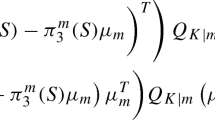Abstract
Logistic discrimination is a well documented method for classifying observations to two or more groups. However, estimation of the discriminant rule can be seriously affected by outliers. To overcome this, Cox and Ferry produced a robust logistic discrimination technique. Although their method worked in practice, parameter estimation was sometimes prone to convergence problems. This paper proposes a simplified robust logistic model which does not have any such problems and which takes a generalized linear model form. Misclassification rates calculated in a simulation exercise are used to compare the new method with ordinary logistic discrimination. Model diagnostics are also presented. The newly proposed model is then used on data collected from pregnant women at two district general hospitals. A robust logistic discriminant is calculated which can be used to predict accurately which method of feeding a woman will eventually use: breast feeding or bottle feeding.
Similar content being viewed by others
References
Anderson, J. A. (1972) Separate sample logistic regression. Bio-metrika, 59, 19–35.
Anderson, J. A. (1979) Robust inference using logistic models. Bulletin of the International Statistical Institute, Proceedings of the 42nd Session, 2, 35–53.
Anderson, J. A. (1982) Logistic discrimination. In Handbook of Statistics, 2: Classification, Pattern Recognition and Reduc-tion of Dimensionality (eds P.R. Krishnaiah and L.N. Kanal), North-Holland, Amsterdam, pp. 169–91.
Anderson, J. A. and Blair, V. (1982) Penalized maximum likeli-hood estimation in logistic regression and discrimination. Biometrika, 69, 123–36.
Atkinson, A. C. (1981) Two graphical displays for outlying and influential observations in regression. Biometrika, 68, 13–20.
Atkinson, A. C. (1985) Plots, Transformations and Regression. Clarendon Press, Oxford.
Bond, S. and Gregson, B. A. (1992) Development and validation of an instrument to predict infant feeding orientation. Report No. 52, Health Service Research Centre, University of Newcastle upon Tyne.
Cook, R. D. and Weisberg, S. (1982) Residuals and Influence in Regression. Chapman & Hall, London.
Cox, D. R. (1966) Some procedures associated with the logistic qualitative response curve. In Research Papers in Statistics: Festschrift for J. Neyman (ed. F.N. David), Wiley, New York, pp. 55–71.
Cox, T. F. and Ferry, G. (1991) Robust logistic discrimination. Biometrika, 78, 841–9.
Day, N. E. and Kerridge, D. F. (1967) A general maximum likelihood discriminant. Biometrics, 23, 313–23.
Francis, B., Green, M. and Payne, C. (eds.) (1993) The GLIM System, Release 4 Manual. Clarendon Press, Oxford.
Landwehr, J., Pregibon, D. and Shoemaker, A. (1980) Some graphical procedures for studying a logistic regression fit. Presented at the ASA Annual Meeting, Houston, Texas.
McCullach, P. and Nelder, J. A. (1989) Generalized linear models. Chapman & Hall, London.
Pregibon, D. (1981) Logistic regression diagnostics. Annals of Statistics, 9, 705–24.
Author information
Authors and Affiliations
Rights and permissions
About this article
Cite this article
COX, T.F., PEARCE, K.F. A robust logistic discrimination model. Statistics and Computing 7, 155–161 (1997). https://doi.org/10.1023/A:1018530001135
Issue Date:
DOI: https://doi.org/10.1023/A:1018530001135




